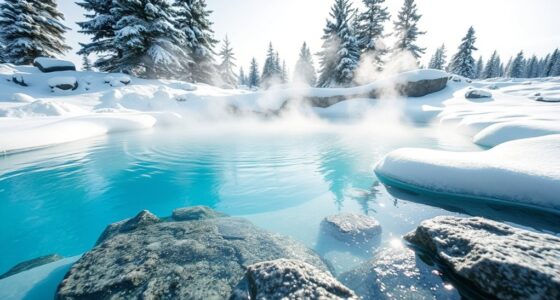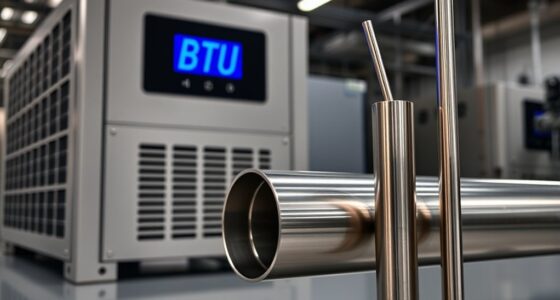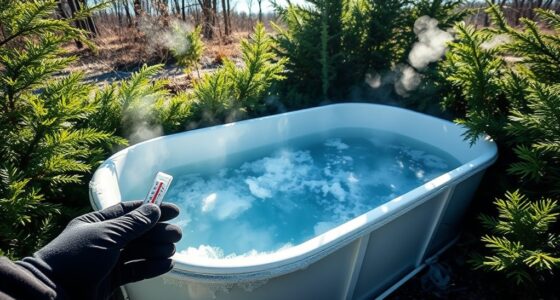Many people believe hot water is always safe and cold water is risk-free, but both can pose hazards if not managed properly. You might think safety targets only matter in hospitals, or that older adults tolerate hot water better, but neither is true. Lower temperatures don’t guarantee bacteria won’t grow, and inconsistent monitoring can lead to unseen dangers. Keep going to uncover the truth behind water temperature safety and how to protect yourself.
Key Takeaways
- Hot water is not always safer; excessively hot water increases burn risk, especially for vulnerable populations like children and the elderly.
- Lower water temperatures do not guarantee bacterial elimination; bacteria like Legionella can still grow at cooler levels.
- Proper water safety depends on combined measures, including temperature control, regular monitoring, and water system maintenance.
- Not all water temperature standards are universal; safety varies based on water quality, plumbing, and usage environment.
- Relying solely on temperature to prevent bacterial growth or burns overlooks the importance of technology and routine safety checks.
The Myth That Hot Water Is Always Safe for Everyone

Many people assume that hot water is always safe because it effectively kills germs and bacteria. However, this isn’t always true for everyone, especially vulnerable populations like children and the elderly. Relying solely on hot water can lead to accidental scalds if water heater settings aren’t properly adjusted. To prevent injuries, it’s essential to prioritize scald prevention by setting your water heater to a safe temperature—ideally around 120°F (49°C). Higher temperatures increase the risk of burns, especially during quick contact. Remember, hot water isn’t inherently safe for everyone; proper water heater settings help balance cleanliness with safety. Always test water temperature before use, and consider installing anti-scald devices to minimize risks. Additionally, some water parks feature water temperatures that are carefully regulated to ensure safety for all visitors, highlighting the importance of proper water temperature management.
Believing Cold Water Is Completely Risk-Free
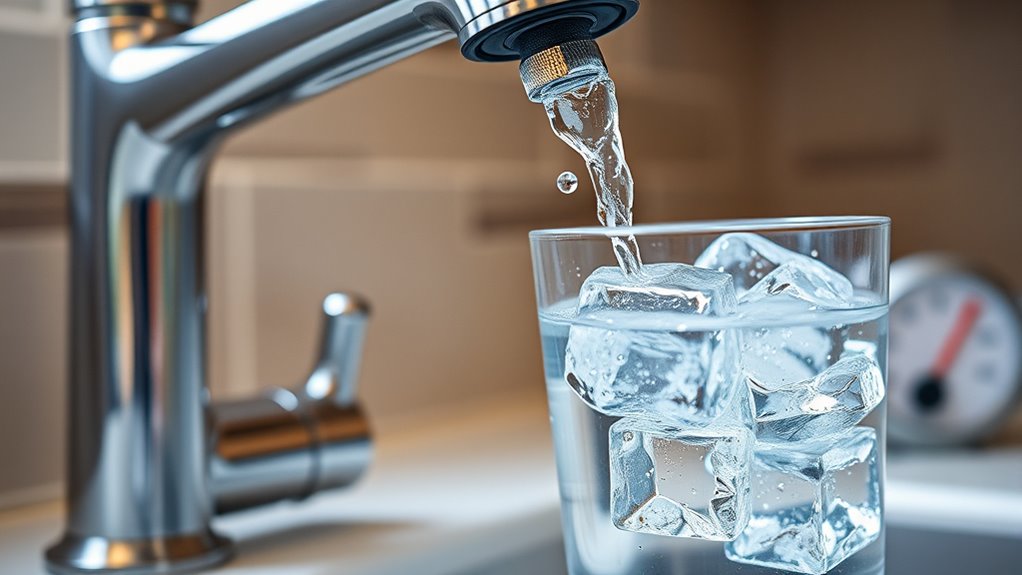
While cold water might seem harmless, it’s not entirely risk-free. Cold water can disrupt water chemistry and impair your body’s temperature regulation, especially in prolonged exposure. You might think lower temperatures mean fewer dangers, but cold shocks and hypothermia are real risks. Here’s a quick look:
| Water Temperature | Effects on Body | Water Chemistry Changes |
|---|---|---|
| 50°F (10°C) | Cold shock, numbness | Altered mineral solubility |
| 60°F (15.5°C) | Reduced flexibility | Increased corrosion risk |
| 70°F (21°C) | Less immediate danger | Stable chemistry |
| 80°F (26.5°C) | Possible microbial growth | Less impact on chemistry |
Knowing how water chemistry impacts temperature regulation helps you understand that cold water isn’t risk-free. Water chemistry plays a crucial role in maintaining safe and stable environments, especially when dealing with temperature variations.
Assuming All Water Temperatures Are Equal in Safety
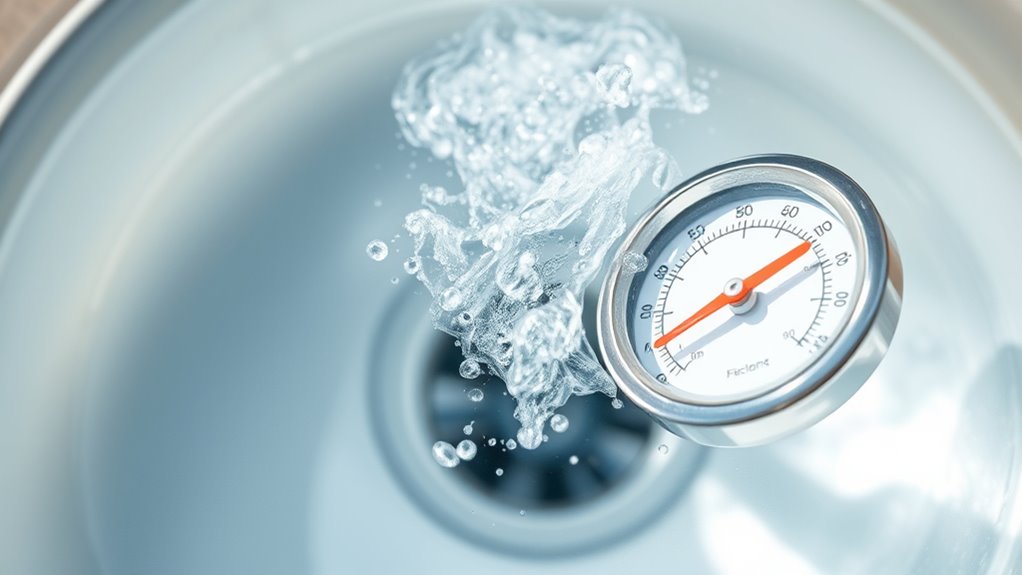
Assuming all water temperatures pose the same safety risks is a common misconception that can lead to dangerous oversights. Not all water temperatures are equally safe, especially when water quality and plumbing standards vary. Hot water may kill bacteria, but excessively high temperatures can cause burns or scalds. Conversely, lower temperatures might reduce burn risk but can encourage bacterial growth if plumbing standards aren’t properly maintained. Plumbing standards influence how water is heated, stored, and distributed, affecting safety and quality. Additionally, water temperature regulation is crucial for ensuring safety and preventing health hazards. Ignoring these differences can lead you to underestimate risks or overlook necessary precautions. It’s essential to recognize that safe water temperature isn’t a one-size-fits-all figure but depends on factors like water quality and proper plumbing practices to guarantee safety for everyone.
Thinking Temperature Targets Are Only Important for Hospitals

Many people believe temperature targets matter only in hospitals, but that’s not true. Home settings also face risks if water is too hot, especially for children and the elderly. Ignoring this can lead to serious burns or other injuries outside healthcare facilities. Additionally, with the increasing integration of AI-driven safety measures, more households are adopting AI safety innovations to monitor and control water temperature, helping prevent accidents before they happen.
Hospitals as the Main Focus
Although hospitals often receive the most attention when it comes to water temperature safety, this focus shouldn’t imply that other settings are immune to risks. Proper temperature control is crucial everywhere, not just in medical facilities. In hospitals, strict water safety protocols aim to prevent infections and scald injuries, making precise temperature regulation essential. However, many assume that water safety concerns only healthcare environments. In reality, water temperature management is essential in places like schools, gyms, and public venues. Unsafe water temperatures can cause burns or harbor bacteria, posing risks to everyone. Recognizing that hospitals are a main focus doesn’t mean other areas are safe by default; it emphasizes the importance of consistent temperature control across all settings to protect public health. Proper system design and regular maintenance cost‑of‑ownership math are vital to ensure safety and efficiency everywhere.
Home Settings Overlooked
While hospitals have strict protocols for water safety, people often overlook similar risks in their own homes. Many assume that water temperature management is only vital in medical settings, but your home needs attention too. Regular water heater maintenance is essential to prevent overheating or bacterial growth, which can cause scalds or illnesses. Following residential safety protocols helps protect everyone, especially children and the elderly, from accidental burns. Setting your water heater to a safe temperature and inspecting it periodically ensures consistent safety. Proper water heater maintenance is a simple yet effective way to prevent potential hazards. Don’t ignore these simple steps—home safety isn’t just about locks and alarms; proper water temperature management is a fundamental part of protecting your family from preventable injuries. Small actions can make a big difference in preventing accidents.
Risks Beyond Healthcare
People often assume that water temperature safety is only crucial in hospitals, but this mindset overlooks the risks present in everyday environments. Whether at public pools, schools, or community centers, improper water safety can cause serious injuries or burns. Many underestimate how quickly hot water can harm children or vulnerable adults. Developing risk awareness around water temperature is essential beyond healthcare settings. It helps you recognize hazards and take preventative measures, like setting appropriate temperature limits and supervising water use. Ignoring these risks can lead to preventable accidents that affect anyone, regardless of age or location. Ensuring proper water safety practices outside of hospitals isn’t just a precaution—it’s a vital step in protecting everyone from avoidable harm. Additionally, understanding temperature control technology can significantly reduce the likelihood of accidents.
The Misconception That Older Adults Can Tolerate Hot Water Better
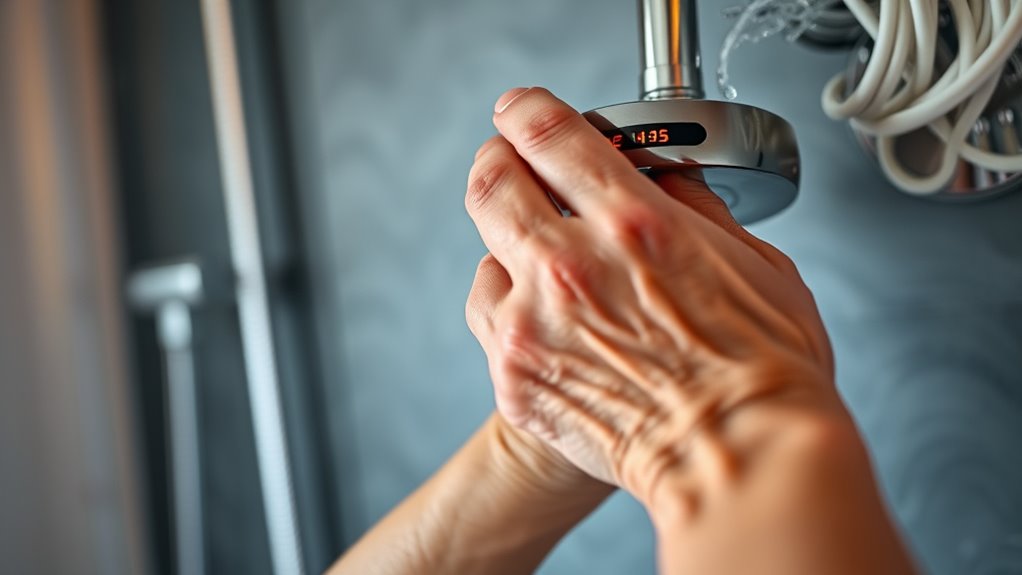
Many assume that older adults can handle hotter water because they’ve built up a tolerance over time. However, this is a misconception that can jeopardize elderly comfort and safety. Aging skin becomes thinner and more fragile, making it less resistant to burns from hot water. Tolerance doesn’t increase with age; instead, sensitivity often decreases, putting seniors at higher risk of injury. Relying on the idea that they can handle higher temperatures ignores these physical changes. You should prioritize lower water temperatures to protect elderly skin from burns and discomfort. It’s a common mistake to think older adults can endure hotter water, but their skin’s aging process actually makes them more vulnerable. Ensuring safe water temperatures is essential for their well-being and comfort. Recognizing the age-related changes in skin can help inform better safety practices.
Believing That Lower Temperatures Always Prevent Bacterial Growth
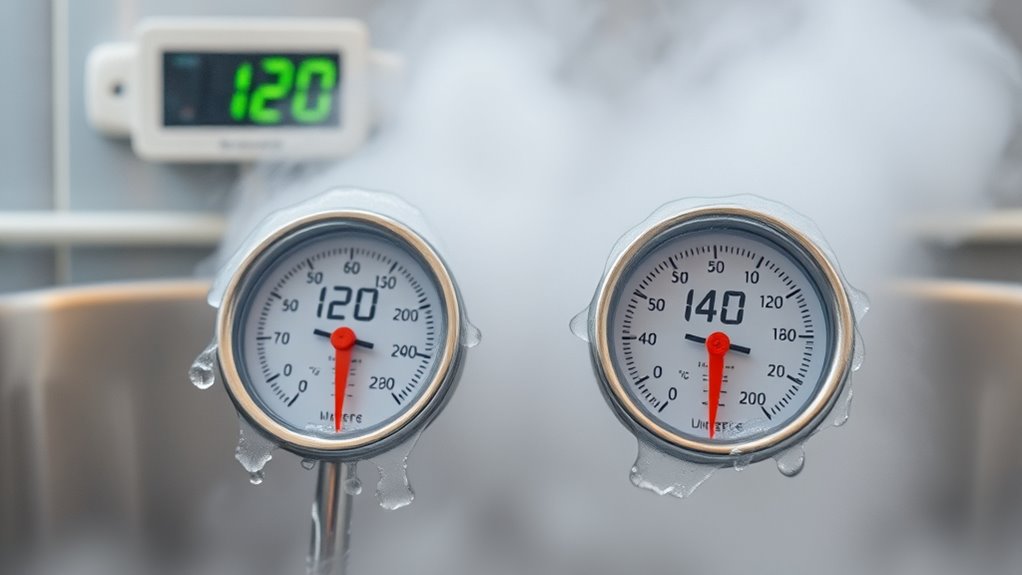
You might assume that lowering water temperatures always prevents bacterial growth, but that’s not entirely accurate. While cooler water can slow bacterial proliferation, it doesn’t stop it completely. Proper temperature regulation is essential because bacteria can still thrive at lower temperatures, especially if the water isn’t consistently maintained. Relying solely on cold water to prevent bacteria gives a false sense of safety and can be dangerous. In fact, bacteria such as Legionella grow best in temperatures between 77°F and 112°F. Consequently, focusing only on lowering water temperature without considering other safety measures can lead to bacterial buildup. Understanding bacterial growth patterns is crucial for effective prevention. To effectively reduce risks, you need a balanced approach that involves proper temperature regulation and other preventive strategies.
Overlooking the Importance of Consistent Temperature Monitoring
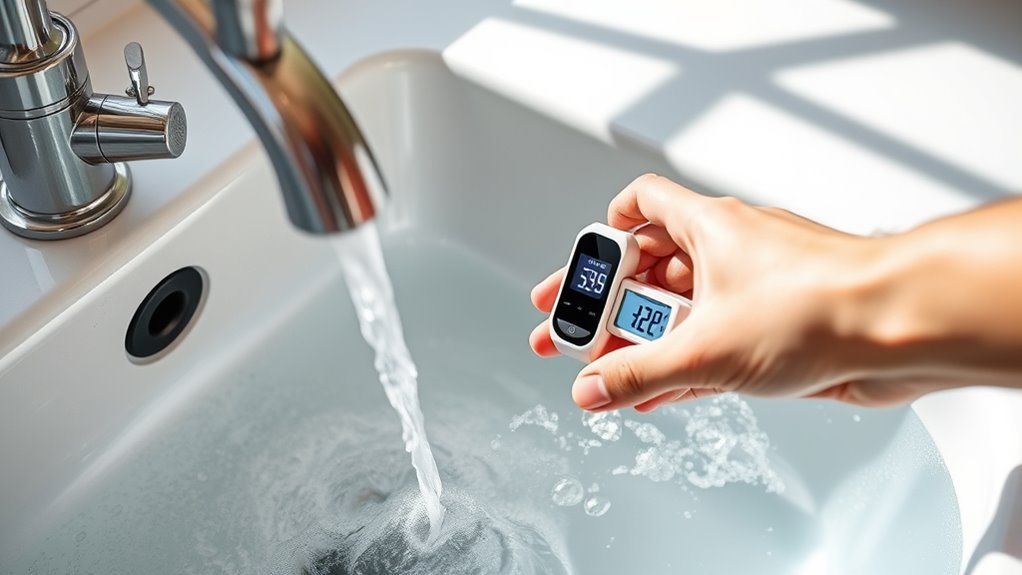
Failing to monitor water temperatures consistently can create dangerous gaps in safety. Without regular checks, you risk losing temperature consistency, which is essential for effective safety measures. Inaccurate monitoring undermines your ability to maintain proper water temperatures, potentially allowing bacteria to thrive or causing scalding hazards. Ensuring monitoring accuracy means using reliable equipment and checking it frequently. When you overlook consistent temperature tracking, small fluctuations can go unnoticed, leading to unsafe conditions. To protect everyone, you must establish a routine for monitoring water temperatures and verify readings regularly. Proper use of AI detection methods can help identify anomalies in temperature data, further safeguarding safety. This vigilance helps maintain the correct temperature targets, reducing risks and promoting safety. Remember, consistent monitoring isn’t just a best practice—it’s a critical step in safeguarding water safety for everyone involved.
Frequently Asked Questions
How Often Should Water Temperature Be Checked for Safety?
You should check your water temperature at least once a month to guarantee safety, especially if you have a thermostat that may need calibration. Regular temperature monitoring helps you catch any fluctuations that could pose scalding risks or bacteria growth. Always verify your thermostat calibration and adjust as needed, and don’t forget to routinely test the water temperature with a reliable thermometer to maintain safe levels consistently.
Are There Specific Temperature Guidelines for Different Age Groups?
Yes, there are age-specific guidelines for water temperature recommendations. For infants and young children, keep water below 120°F (49°C) to prevent burns. Older adults should also follow these guidelines, as their skin is more sensitive. For general safety, aim for around 120°F (49°C), but always modify based on individual needs and circumstances. Regularly check water temperature to make certain it stays within safe limits for each age group.
Can Water Temperature Fluctuations Increase Bacterial Risks?
Imagine your water heater as a delicate dance partner—if it wobbles with temperature fluctuations, bacterial growth can take center stage. Sudden changes in water temperature disrupt the stability needed to keep bacteria at bay. When temperatures aren’t steady, bacteria can multiply quickly, increasing health risks. To keep your water safe, maintain consistent temperature control, ensuring a stable environment that minimizes bacterial growth and keeps everyone protected.
What Are the Best Practices for Maintaining Consistent Water Temperature?
You should regularly check and adjust your water heater’s temperature calibration to guarantee consistent settings. Use a reliable thermometer to verify water temperature and make adjustments as needed. Implement flow regulation techniques, such as adjusting valves or using flow restrictors, to maintain steady temperature levels. Consistent maintenance and monitoring help prevent fluctuations, reducing bacterial risks and ensuring safer water for everyone.
How Do Water Heater Settings Impact Overall Safety Protocols?
They say “better safe than sorry,” and that’s true when it comes to water heater settings. Your temperature adjustments directly impact safety standards by preventing scalding and bacterial growth. Keep the thermostat at 120°F to balance safety and efficiency. Regularly check and adjust the settings to avoid risks. Properly maintained water heater settings protect you and your family, ensuring safety remains a top priority in your home.
Conclusion
So, next time you think hot water’s always safe or cold water’s risk-free, remember how easily these myths can trip you up. You might assume hospitals have it all figured out, but even they can fall for these misconceptions. Ironically, the real danger isn’t in the water’s temperature itself but in ignoring consistent monitoring. Stay vigilant—because in water safety, the biggest mistake is trusting your assumptions instead of the facts.


